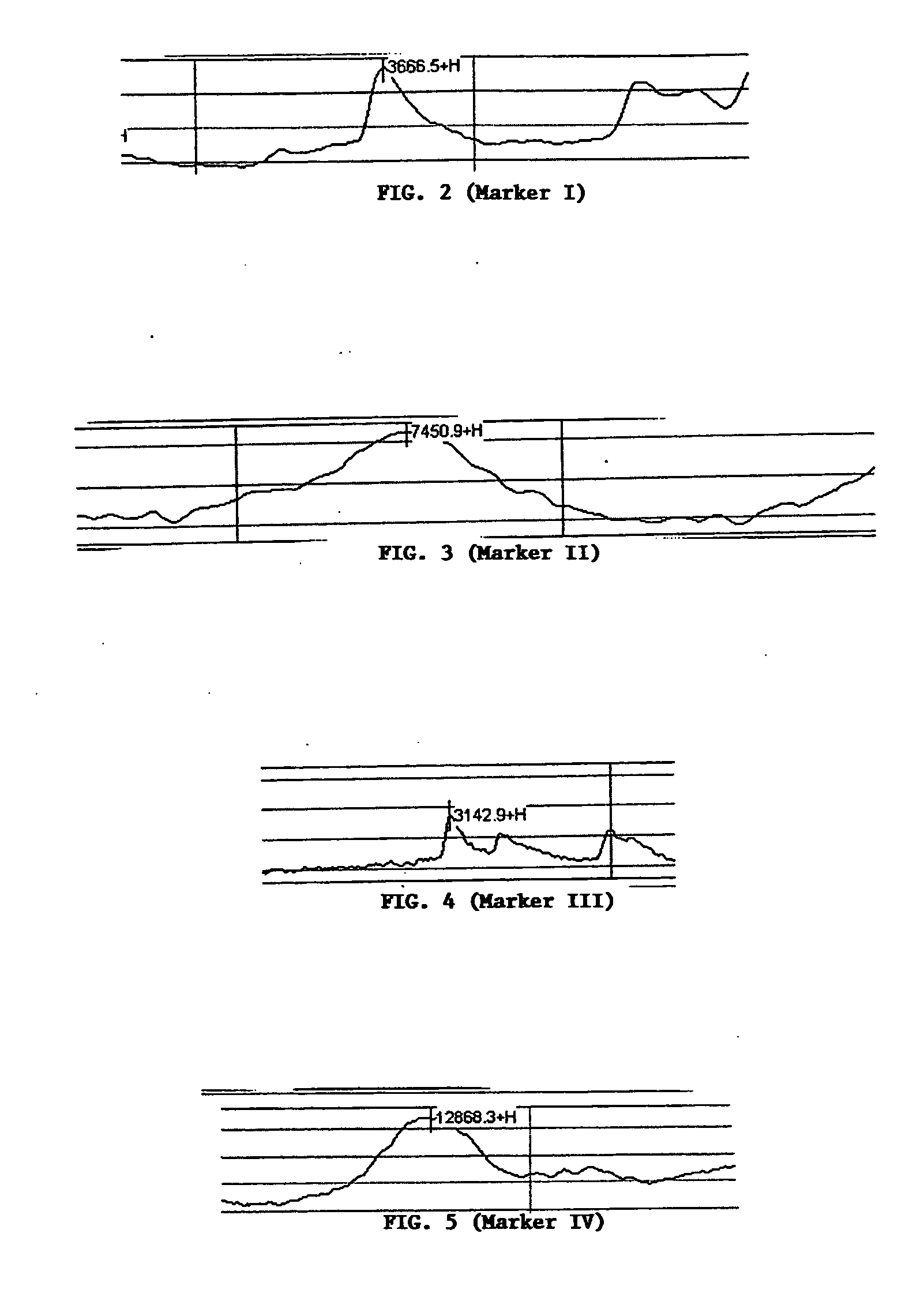Identification of biomarkers for detecting pancreatic cancer
a biomarker and pancreatic cancer technology, applied in the field of biomarkers, can solve the problems of insufficient accuracy of most widely used serum markers for pancreatic cancer, resectable cancer, and 10-15% of patients present with small tumors,
Inactive Publication Date: 2005-05-05
CHAN DANIEL +6
View PDF0 Cites 111 Cited by
- Summary
- Abstract
- Description
- Claims
- Application Information
AI Technical Summary
Benefits of technology
[0006] The present invention provides, for the first time, novel protein markers that are differentially present in the samples of human cancer patients and in the samples of control subjects. The present invention also provides sensitive and quick methods and kits that can be used as an aid for diagnosis of human cancer by detecting these novel markers. The measurement of these markers, alone or in combination, in patient samples provides information that diagnostician can correlate with a probable diagnosis of human cancer or a negative diagnosis (e.g., normal or disease-free). All the markers are characterized by molecular weight. The markers can be resolved from other proteins in a sample by using a variety of fractionation techniques, e.g., chromatographic separation coupled with mass spectrometry, or by traditional immunoassays.
Problems solved by technology
Unfortunately, only 10-15% of patients present with small, resectable cancers.
Despite improvements in diagnostic imaging, diagnosis may be delayed in some patients for a variety of reasons including the presence of a small cancer (1, 3), the presence of a cancer that diffusely infiltrates the pancreas without forming a mass, because of delayed access to diagnostic services such as endoscopic ultrasound and fine needle aspiration, or because of the low sensitivity of cytology from fine needle aspiration.
Unfortunately, the most widely used serum marker for pancreatic cancer, CA 19-9, is not sufficiently accurate to be useful as a diagnostic test, especially for identifying patients with small surgically resectable cancers.
Method used
the structure of the environmentally friendly knitted fabric provided by the present invention; figure 2 Flow chart of the yarn wrapping machine for environmentally friendly knitted fabrics and storage devices; image 3 Is the parameter map of the yarn covering machine
View moreImage
Smart Image Click on the blue labels to locate them in the text.
Smart ImageViewing Examples
Examples
Experimental program
Comparison scheme
Effect test
examples
Materials and Methods
the structure of the environmentally friendly knitted fabric provided by the present invention; figure 2 Flow chart of the yarn wrapping machine for environmentally friendly knitted fabrics and storage devices; image 3 Is the parameter map of the yarn covering machine
Login to View More PUM
| Property | Measurement | Unit |
|---|---|---|
| molecular mass | aaaaa | aaaaa |
| temperatures | aaaaa | aaaaa |
| time | aaaaa | aaaaa |
Login to View More
Abstract
The present invention relates to a method of qualifying pancreatic cancer status in a subject comprising: (a) measuring at least one of the disclosed biomarkers in a sample from the subject and (b) correlating the measurement with pancreatic cancer status. The invention further relates to kits for qualifying pancreatic cancer status in a subject.
Description
[0001] This application claims the benefit of U.S. provisional application No. 60 / 467,501, filed May 2, 2003, and U.S. provisional application No. 60 / 542,618, filed Feb. 5, 2004, both of which applications are incorporated herein by reference in their entirety.FIELD OF THE INVENTION [0002] The invention provides biomarkers important in the detection of pancreatic cancer and for the reliable detection and identification of biomarkers, important for the diagnosis and prognosis of pancreatic cancer. The serum protein profile in pancreatic cancer patients are distinguished from non-neoplastic individuals using SELDI analysis. This technique provides a simple yet sensitive approach to diagnose pancreatic cancer using serum or plasma samples. BACKGROUND OF THE INVENTION [0003] Pancreatic adenocarcinoma currently has the lowest survival rate for any solid cancer (1, 2). Despite progress in the understanding of etiology and pathogenesis of pancreatic adenocarcinoma, the 5-year survival of p...
Claims
the structure of the environmentally friendly knitted fabric provided by the present invention; figure 2 Flow chart of the yarn wrapping machine for environmentally friendly knitted fabrics and storage devices; image 3 Is the parameter map of the yarn covering machine
Login to View More Application Information
Patent Timeline
 Login to View More
Login to View More Patent Type & Authority Applications(United States)
IPC IPC(8): C12QC12Q1/68G01N33/574
CPCC12Q1/6886G01N33/57438C12Q2600/158
Inventor CHAN, DANIELZHANG, ZHENKOOPMANN, JENSGOGGINS, MICHAELWHITE, C.FUNG, ERICMENG, XIAO-YING
Owner CHAN DANIEL
Features
- R&D
- Intellectual Property
- Life Sciences
- Materials
- Tech Scout
Why Patsnap Eureka
- Unparalleled Data Quality
- Higher Quality Content
- 60% Fewer Hallucinations
Social media
Patsnap Eureka Blog
Learn More Browse by: Latest US Patents, China's latest patents, Technical Efficacy Thesaurus, Application Domain, Technology Topic, Popular Technical Reports.
© 2025 PatSnap. All rights reserved.Legal|Privacy policy|Modern Slavery Act Transparency Statement|Sitemap|About US| Contact US: help@patsnap.com



